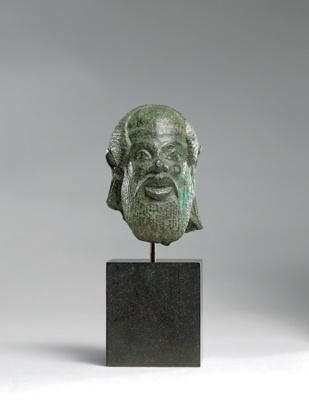
Bronze
H: 3.6 cm
Allegedly from Selinunte
Greek work from Sicily
c. 460 B.C.
Solid-cast by the lost wax process, carefully chased in the cold and burnished.
Condition: patina greyish green with a malachite green deposit on upper left of beard, blackish to brownish red metal showing through in spots. Once part of a statuette, unevenly broken off at the neck, with the lower part of the hair at the back missing. Point of beard bent back and damaged. Blows to tip of nose, left cheek, occiput, right ear, and a few dents.
This head of a silenos is very lively and has an individualized expression, almost as though he were a portrait - and a portrait he is, but not so much of an individual as of a type. In style he is already far removed from archaic depictions with his high balding pate, wide eyes, pug-nose, thick lips, moustache and long oval beard. He is to be dated towards the end of the Severe Style.
Whether this head surmounted a statuette, as we think, or was attached to a handle is uncertain.
Silenoi were a favoured subject with the Greeks, illustrated on red-figure vases, and reproduced in bronze and terracotta sculptures. They are the subject of a group of lebes handles perhaps from a workshop at Cumae [1] though these are different in style. There is no good comparison for this piece, though terracotta masks of silenoi have been found in Rosarno [2] (ancient Medma, a nearby colony of Locri). A bronze satyr with amphora bears resemblance for the face; he is dated towards the mid 5th century B.C. and attributed to a Campanian (?) workshop [3], a sensible attribution, we feel. From the sanctuary of Malophoros at Selinunte a group of late archaic terracotta silenoi masks were found [4]. Though obviously earlier in date, there would appear to be a resemblance for the outline of the eyes. Thus, we would have a tradition for the type that fits the alleged provenance.
He is surely to be ascribed to Sicily though the workshop is undetermined.
1 See Crouching Youth, cat. no. 132, text and footnotes 6,8,9,10.
2 Arias, P.: Scavi di Calabria (dal 1939 al 1942), NSc 1946, pp. 135-136, fig. 2.
3 Fabing, S.: The Gods Delight. The Human Figure in Classical Bronze (Cleveland, 1988), no. 42, pp. 232-235.
4 Gabrici, E.: Il santuario della Malophoros a Selinunte, MonAnt 32, 1927, p. 222, pl. XLI,3.